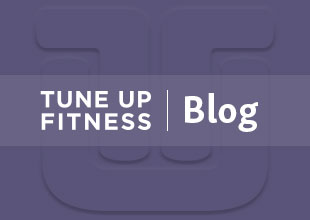
Have you ever wondered what to prioritize when you are doing a yoga pose? What is the most important thing to focus on when doing Triangle? Or Downward Dog? Or Savasana? Ask 15 different yoga teachers from different yoga lineages and you will likely get 15 different answers. Is alignment the most important? Is it the breath? Awareness? Eye gaze? What is it?
I have wrestled with this question myself and have attempted to deconstruct hundreds of poses to figure out what is most important … but after 29 years of practice (yep, I’ve been practicing since I was a kid!) there is one element that I come back to again and again — and it might surprise you!
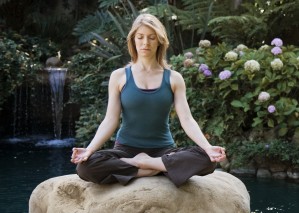
Relaxation is the doorway
The backbone of every pose is not your vertebrae, but rather what lies inside of them: your nervous system. Your brain, spinal cord and peripheral nerves are gateways of input and output for our bodies. Their ability to relay messages to and from our tissues is critical for being able to perform a pose (or any movement whatsoever). But if your mind is caught up in a bind, stressing out about how to do a pose or “getting it right,” you add tension to your whole system.
What I am suggesting here is that we need to consciously dampen our stress response in order to create a better environment for the full spectrum of sensing into our tissues and our movements. In other words, we must imbue our mind with relaxation as a prelude to posing. The yogis call this Unmani Mudra, or “no-thought mind.”
Line the mind with meditation
It is fairly easy to flip the ON switch in the body, as most of our brain is actually dedicated to helping the body be aroused and alert. But how do you flip your OFF switch? Much less of our brain-space is dedicated to chilling out and it becomes even more challenging when we ask ourselves to let go but are unsure whether or not we’re still holding on.
When a body deeply relaxes, it temporarily loses muscle tone (as soon as you start using your body again, the muscles spring back into action), breathing slows down, heart rate slows, body temperature drops and the mind begins to experience space between thoughts. This “space between thoughts” is exactly the entry point the yogis were seeking in coining the term Unmani Mudra.
The challenge when doing poses is to rid yourself of both physical and mental tensions so that you can enter and exit poses with such deep relaxation and concentration that the body and mind experience each pose in its totality. In other words, the mind becomes quiet enough that it can “listen” to all of the nuances of motion, position and sensation that the pose exposes to the nervous system.
Learn about Yoga Tune Up at home.
Find a Yoga Tune Up class or workshop near you.
[Reprinted with permission from Gaiam Life.]



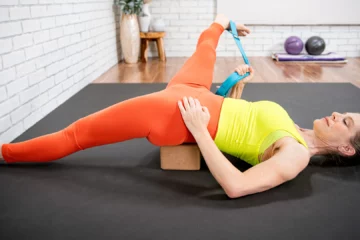
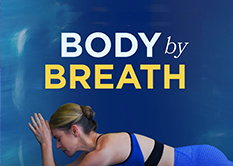

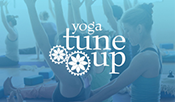


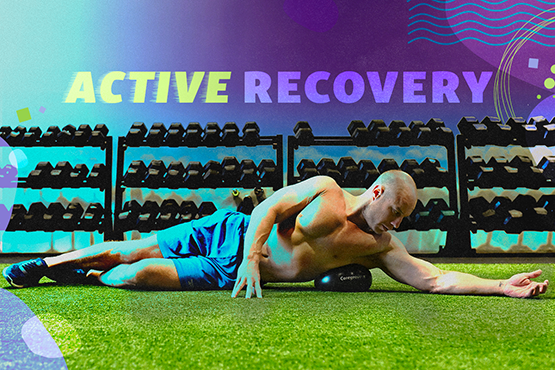
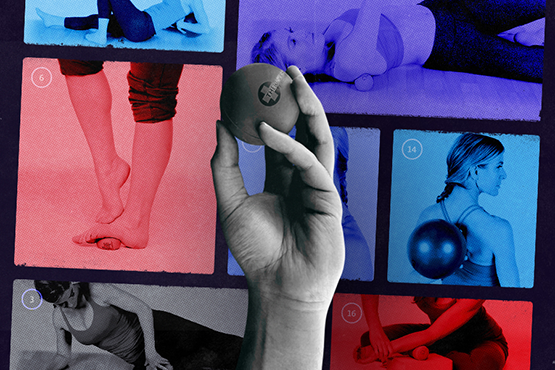
I’ve always thought “alignment” is the most important part of a yoga pose. This gives me another valuable perspective about yoga practice.
I love the idea of “space between thoughts” – it’s difficult to hard to find in yoga and really challenging to practice it in daily life. thanks for the reminder!!
Thank you for this article. I always like to begin my classes, or my own personal practice, with a quiet time, focusing on breath. This is especially important when it’s a large class with lots of high energy in the room as people arrive and set up their space to practice. An opening prayer, a pranayama practice, closed eyes, all bring us “into” ourselves so we may receive the class from the no-thought mind.
I once read in yoga book “what makes these poses sacred is how we inhabit them” that really spoke to me. I do yoga to be closer to me, the me beneath the thinking mind and I can not do this with tension. “Relaxation is the doorway” is so true when I drop into gravity and the breath, I am able to find lightness in my body and find meditation in movement and a still mind and receptive body.
I like the idea of slowing down the mind and finding the space between thoughts as part of an active practice, but I especially like the focus on the what’s going on with our nervous system. Taking time to sit and quiet the mind before class helps to train our nervous system. I look forward to trying this in my classes. Good blog post!
Such a great article! Thank your for this great perspective. I never thought of focusing on our nervous system and relaxing to be able to find the “space between thoughts”. I loved when you made the connection, Where the mind becomes quiet enough that it can listen to sensation, position and motion. Thanks for sharing your immense knowledge Jill! I am learning so much.
Thank you for the reminder of needing to tap into the breath to connect and calm the central nervous system. It is amazing with in just seconds who taping into he parasympathetic nervous system sends signals to the brain for the body to relax. When we are in that state of relaxation we can enter and end a pose withe ease and avoid injury.
This is a very interesting perspective to use regarding Yoga asana practice. All too often we use the asana to get into our body. Changing our emphasis to consciously relax the body, allow the parasympathetic nervous system to become more sensitive & tune in to the nuances of each & every detail of movement & really make a mind body connection.
Sometimes the obvious and most simple thing is also the hardest thing to do. I remember attending my first yoga class and listening to the teacher talk about turning my attention inward and slowing my breath down when all I wanted to do was get on my mat and do the physical part of the asana. It is only in recent years that I have understood the idea of my mind and body being on the same team and learning to relax in a pose. There is still a lot of learning to be done though. Thank you, Jill for the article.
Less is more. Less thought, less trying, and more being. I love that your answer to this question is relaxation. So many students want to do it right and they get all caught up in what they should be feeling and what they should look like in a certain position. Being in the YTU Level I training currently I find myself getting caught up in technique and then we are cued back into our breath and I can find myself back into my body with more ease. Thank you for your teachings and making breath just as important as the alignment of our bones and joints.
Jill, I’m so curious how you came to make proprioception one of the main focuses of your practice? I absolutely love how explicit you are in training people to tune into this sense!
I have found that walking my mind through my body is an easy way to flip the “off” switch. Taking my thoughts to all of my body parts and not trying to manipulate them in any way just making myself aware of my body lulls me in to a meditative state. When I’m in a yoga post, it’s a little more difficult but I try to start from the bottom up and organize my body into the pose.
This post was a great reminder about the importance of relaxation and meditation during the asana practice. When I first started practicing yoga my mind was filled with so much chatter and self-criticism, and it took me a while (and a conscious effort) to learn to focus on my breathing and quiet the intrusive thoughts that were constantly running through my head. Now that I am participating in teacher training, I find myself faced with this challenge again–there’s so much new information that I’m trying to incorporate in my practice, and I’m also dealing with a resurgence of feeling not good enough. I think focusing on relaxation and meditation–which for me is about self-acceptance–will be a great way to stay present in the moment and allow all of the newfound knowledge to settle in.
This is so true and a very hard concept to teach. It took me many years to turn the chatter off in the mind . I understand the mind/body connection now and it is wonderful to be in a class as a student and be relaxed in the asanas. Yoga is so much about listening to the body and not allowing the mind to take over. The mind and the body need to work in unison to avoid injury and to not cause more stress to the body. When I see students, pushing, pulling and straining, I have everyone come back to center whether it be tadasana or sukasana and I tell them to close their eyes, take a deep breath and pause. It is still exciting to me when a student comes up after class and they say “I got it, I relax and my body moves.”
I would be sooooo over yoga by now if I never learned that pleasure is the path of least resistance to being embodied. I remember years ago, i actually became allergic to the word vinyasa. If I even thought of doing another one, i just felt my throat to womb contract. Yes, ‘listening’ to this reaction was how I found my truth around where my yoga practice was going next.
I really appreciate this post for putting the emphasis on the part of practice that so often gets left til the fast few minutes in savasana. Thinking about turning on the OFF switch of the mind (without just checking out) in order to experience the poses more fully is a wonderful way to approach asana. I have found personally that when I’m regularly practicing restorative yoga and using the YTU balls, it’s so much easier to flip the OFF switch and stay in that place no matter what kind of asana practice I’m in. Taking the time to chill out deepens all the parts of our yoga practice.
It seems more important now than ever to learn and practice relaxation. Whether I am doing or trying not to do, I enjoy watching the breath and taking an extended gentle pause in between the breath ex-change. I find hovering my awareness in the space in between the breath is so rich with insight and allows the realization of the Unmani Mudra, the no thought mind.
As a yoga teacher, I often find myself encourage students to engage, to strengthen, to flex and sometimes play with their edge, so your idea of “relaxation as a doorway” really made me think hard. Is Gentle the new Power? Is Relaxation the new Engagement? This new idea is so refreshing. The body and mind are so connected in a sub level and we don’t even conscious of how exactly they communicate. Like if someone asked us to kick, we don’t even need to decide which muscles to contract to make the action happen, it just happens. With times, we’re losing our kinetic intelligence and the ability to sense what’s going on inside and out. So, maybe by relaxing both our mind and body, we can finally stay honest with ourselves and not compensating and sacrificing integrity for deeper range of movement.
As a teacher I find that taking sufficiant time to center the class has an effect on the students practice. Downregulating and bringing the breath into equanimity at the onset of class complety enhances the practice. It sets the tone as group and individually, balancing the nervous system and receptivity of my students. The mind, and body both are more open to observing and learning about themselves.
I like to use the example of the switch being turned of and on as a comparison of concealing and revealing.
When the switch is turned off the revelation of the true nature of our Self is revealed.
Hi Jill, we are now halfway through YTT at Pure and I’ve been contemplating this – specifically for Downward Facing Dog. Your answer of Unmani Mudra brings a lot of light. Through “no thought mind” I believe as long as you know the physiology of the poses in which our teachers have equipped us with our breath and mind will lead us into our pose.
Love this. I think this is something we develop as we mature in our practice.
If students didn’t have to wait 5, 10, 15 years to discover it, how much more effective would their practice be? Or their lives in general?
Such a hard concept to grasp in a society where achieving, driving, pushing, striving are the model and relaxation is not practiced or often unconscious and sloppy if it is.
I remember my first year of teaching saying “relax your face” many times to students but I never had any idea that relaxing your face had any other effect than that. I said it because my teacher said it and though generally I got the concept that those constipated//lifting heavy weight/pursed lip-gritted teeth-wrinkly forehead faces were not helping their practice, I knew nothing beyond that–I.e. hello nervous system! YTU training(all of it) has taught me egads of information about the nervous system and how it operates; it’s effects on the body AND our ability to effect it–powerful stuff! I have to say my fave part of this article was the link to the “accessorize” article on the Gaiam blog. Good choice Jill and so relevant.
I have come to know this in my classes and in my own practice. I find that when I do a series of poses and then just sit seza before beginning again, I notice that each seza sitting session becomes more down regulating and I am more refreshed and available to experience the poses that follow. I feel less tense and more aware after each seating. Instead of refilling, I use that time to empty and extend that emptiness further into the practice. I still struggle with the first minutes of savasana. It seems that moment the teacher is bringing us out is the moment I am ready to go deep!
As a studio owner faced with the day to day operations and the constant interaction with students it is sometimes difficult to still the mind. But I have learned that when I enter the studio room to teach I can instantly ‘turn the switch’ and teach the class without thinking of what is happening on the other side of the door. Also when I take a class I can ‘still’ myself and using the breath I can totally enjoy and relax my way through the class. “Relaxation is the doorway”! Great article!
WHAT I LOVE ABOUT MY YOGA INSTRUCTOR IS THAT SHE ALWAYS REMINDES US TO BREATH AND WHEN I BREATH, MY IND QUIETS, WHICH HELS ME EASE INTO MY PRACTICE IN AN EFFORTLESS MANNER. MY TEACHER CALLS THIS PRACTICE OF YOGA: EFFORTLESS EFFORT! THANK YOU FOR SHARING!
Great point, great article! Actually struggled with this at Vinyasa on Thursday night because I could ‘turn off’ my thoughts, therefore was somewhat struggling in binds. Although something miraculous happened by the end of the class during mediation– I was able to be completely still in mind and easily FLOW into meditation with a tall spine and renewed spirit.
OH this is one of my most agonizing concerns with my students. I see so many of them hunched up and straining in a pose to try and get as deep as the yogi next to them. And the I go to try to adjust them and they’re like a rock, stiff as can be from all the stress of trying to ‘get it right’! It’s so hard to convey the approach of relax and let the pose fit into you instead of trying to look like the yogi next to you. Less thinking more relaxing!
This is exactly why I ask students to assume the shape of a pose, then pause – breathe and soften before proceeding! Yoga shouldn’t be stressful!
Especially in working with my private clients I see this barrier to relaxation quite a bit. Since this demographic either may not be able to clear their schedules sufficiently to get to a studio/class, or they prefer the one on one attention, I often find that the obstacle to getting the most they can from a session depends on how active or overactive their minds are. But really there is no specific text, instruction or methodology for bringing ease to the mind but practice, practice, practice on and off the mat. The mat is often where our awareness of our thoughts begins, but the key is to notice these moments not only in the presence of an instructor, or in a room with low lit candles and soft music, but when we find ourselves most stressed in life in flight or fight response mode.
I was obsessed with Alignment from studying with many algnment based teachers. However, as my practice grew, the commponet that was missing is the mind body connection for each pose. I used to think that doing 20 handstands will get me stronger and improve my practice. Now, even just one good one and I take my time feeling through the web of my body and noticing the effect of the pose when I come out of it is what I do now. However, I do feel that learning to practice correctly so that you don’t damage your body is the key to reaping the benefits of yoga in a much later stage.
I really appreciate this idea and think that it is one (of many!) that applies to so much outside of Yoga. I’m wondering if there is a trick to maintain the “no thought mind”, at least in part, after the muscles have bee fired up into a dynamic pose. Sometimes after relaxation I get a student into a pose and they are excited to fully explore it and then they come out of it in a way that seems too quick. Any pointers on how to maintain the calm?
Thanks. I love this: “In other words, the mind becomes quiet enough that it can “listen” to all of the nuances of motion, position and sensation that the pose exposes to the nervous system.”
I love to think of poses as exposing information to the nervous system. You know, when I consider your words about relaxation, I think of being in a “receptive” mental stance in a posture. I think of awakening the senses so that they may experience the teachings of the posture. So, I relax my listening, my seeing, my feeling, my smelling, my tasting….so that internally (and maybe externally), I will be able to perceive, or “sense” the posture. I believe that with time, we really can smell, taste, hear, touch, see our postures from the inside out.
Thank you for this.
Thank you Jill for this post. I am presently doing my YTU Level 1 with Todd and Amanda, and not coming from a yoga background, I often feel myself “over thinking” the pose or the variation. Today, after learning more about pranayama, I felt more body awareness, and was better able to proprioceive and self-correct rather than panic! It’s not so much that my yogic abilities have suddenly improved, but I am more at ease with where I am in the process.
As a ‘doer’ a overly-active (by necessity often) being a professional contemporary dancer, supporting this career with teaching all over, I moved to yoga after burning out, in order to rest. Shortly after, I changed the spokes on the wheels altogether by becoming a yoga teacher, which I found, for my personality type was less than chill. After five years of really going for it to try to establish yourself amidst the many yoga teachers, It is only now I am able to settle into a more easeful teaching practice. Only now that I am ready to really offer this “time to chill’ to myself, thus, my students. I LOVE how you speak of relaxation, about so many things really. The phrase “line the mind with Meditation” is brillant and calming just to say, to read, to think of. I am ever a student of my mind and body through yoga. I am thrilled to have incorporated and learned from you Jill, as I still have much to learn and practice, in order to better assist my students, yet huge steps are being made and I really see the differences I am making with private clients, in their ability to get deep into their bodies and rest their minds, through my facilitation. This is a gift and I wish to thank you for enabling me to help them even more than before..the path keeps getting richer <3
I really enjoyed reading this post! very simple yet still difficult to do during practice, especially a challenging poses……suddenly my stitch goes “ON”!
I will keep in mind your messege and try to stay “no- thought mind” stage at the next practice and hopefully find the difference from the usual practice.
I have struggled with this question a lot too. Interesting to hear your answer. It brings us back to being mindful in all we do, and to maybe stop striving to get somewhere in such a rush. Being in the moment with every pose can prevent many injuries and teach us so much if we could just relax and listen!
Love this. So simple and so profound. Definitely been a few times in my practice where I’ve struggled to find what was most important in my asana practice… I love that it’s just to be still in my mind and calm in my body.
Thank you Jill, for so concisely “cutting to the chase”. You have beautifully described where yoga differs from other forms of exercise: yoga is a “work-in” vs. and “work-out”. I think that when students experience Unmani Mudra in their yoga practice, it is this experience that brings them back to yoga again and again.
What a lovely post! I wish that I’d had access to this wisdom years ago. So much strain and striving… leading to so much unnecessary tension over the years! Lately, I’ve been practicing cultivation of relaxation and ease as part of my practice now and it’s made a tremendous difference. It’s a practice and it is ongoing. I’ve been using a sankapla to this end, which has been transformative. Thank you!
So simple and yet so difficult. We all strive to create healthier bodies through our yoga practices and yet without knowing our desire can create more of a block if we are not aware of the need to let the body do what it does naturally. I love that you are able to explain how the firing up of the sympathetic system jams up the bodies ability to relay nervous system messages. I will definitely use this explanation to help my students understand the importance of “relaxation is the doorway” and I will add keep the door open.
Unmani Mudra, or “space between thoughts,” comes naturally to me only after 27 yearsdedicated to yoga and learning meditation. I say learning meditation because for me, it was the most difficult thing to do. Moving came naturally, but sitting, allowing stillness in the body and mind – ohmygod – I still recall how 5 minutes of stillness was excruciating to me. then 15 years later when I practiced a 10 day silent retreat was more difficult for me than hours of child labor followed by an emergency c section. This is one reason why I was drawn to arduous physical yoga that just wore me out – then finally I could feel quieter. MY CONUNDRUM AS AN INSTRUCTOR IS THIS: how do I lure the students who need it the most into slowing down and not having to beat their bodies up to finally quiet the mind? My answer is loving kindness, patience, humor, and setting an example. Any additional ideas?
In reply, my CONUNDRUM as an instructor: how, other than loving kindness, patience, humor, and by example, do we lure those who need it most into this place of Unmani Mudra, or “space between thoughts?” The first time I tried to sit still for a 5 minute meditation I found it excruciating. 15 years later when I sallied forth for a 10 day silent vipassana meditation retreat, not only did it cause an enormous fight with my boyfriend who told me in no uncertain terms that a meditation retreat was the last thing he would ever want to do; my own experience was that it was more painful than hours of birth labor followed by an emergency c section. The irony is this same boyfriend, still a friend, and trying earnestly to keep a yoga and a meditation practice, still prefers the knock yourself out, no pain, no gain, kind of classes. And laughingly, I am barely 1/2 a step ahead as his instructor. So how to live happily slowing down? I’m thinking it is one word: PRACTICE. Yep practice that space between thoughts. Thank you!
Day 2 of Level 1 training and I imagine this attitude of relaxation and listening is also important in teaching YTU. I wonder what would be your “most important part of teaching YTU.”
Thanks Jill for reminding us to place importance on receptivity and softness throughout our asana practice. I think that cultivating the breath (and reminding our students to so) activates the parasympathetic nervous system and we are more likely to melt more deeply into our poses both on and off the mat.
I notice that just the mention of certain poses can make a student tense and worried about their “performance”. And isn’t that the way most of us live our lives – worrying about how well we are going to do at that client meeting or other function – bodies tense, breath shallow, etc. I love how you say “the backbone of each pose is not the vertebrae but what lies inside them, the nervous system”. I also love that along with relaxation comes a greater ability for profound concentration! Teaching these concepts on the mat increases the likelihood of practicing off the mat. Thank you Jill!
Oh to teach this approach in the western world – what a challenge! But the benefits would be so great! This approach is the difference between a standard exercise regime and a yoga practice. However many, many students here in the western part of the world come to yoga for the “exercise”. That’s okay, of course, that’s why I started doing yoga, but if we can emphasis Unmani Mudra in our teachings I think students will ultimately be happier and healthier, less injuries more self-awareness – all shorts of good stuff. Thank-you Jill, this did surprise me at first, but now it just makes sense.
Unmani Mudra is the most important aspect to teach to the students before the strain of the physical practice begins. I teach evening classes full of students that were in a tense positions all day, sitting in cars or at their desks. Before we start moving I always offer a relaxation technique to help them to arrive at the place of being able to let go of tension. Make the space in the mind and the body will follow 😉
I really like this, reminds me of the importance of stirah – sukka, banacing ease within effort. As you explained, it needs to happen mentally as well as physically!
I love this post! I find in yoga poses sometimes my mind is focused on the mechanics of the pose and sometimes I can enter the ‘zone’ of the pose – that mental space where I can achieve a deep state of relaxation along with physical alertness. I find that there are some teachers whose teaching brings me into that perfect space of mental and physical alignment and this post describes that concept perfectly.
In my practice I am learning the importance of mental stillness, yet it seems to be the most challenging of all. With every breath I manage to find stillness however within each moment of stillness I find even more mind distraction. Yoga, the endless journey.
Love this post!! I think the biggest struggle I have during yoga is learning how to let go of the day I’ve experienced. Typically if I can focus on my breath, I slowly feel the stress fade from my body.
Excellent point and so true. I am always amazed that if I become aware of my decision to ‘stop breathing” or my mind wandering how simple it is to start breathing or clear my mind and then safely and more comfortably move deeper into my pose. Now only if I could start there….Cant wait to read part 2!
Absolutely! I often forget this and get caught up in monkey mind in my practice. I always know when this has happened because when I’m done with my practice I don’t feel nearly as fulfilled. Finding the place of rest in any pose is where the benefits are truly realized. I find that the more I can relax the more I can relax, the more I’m distracted and tense, the more I’m distracted and tense.
I thouroughly enjoyed reading “why” relaxation is the means to improving your practice – I have heard the statement from teachers before but without the “why” it can bypass most students..Also, what a great attribute to have as a teacher – to be able to “create an envirnoment where adapation can occur” – one that facilitates enough relaxation to allow the individual’s practice to evolve without additional restriction! Thanks Jill!
[…] Tune Up® Blog « The Most Important Part Of A Yoga Pose, Part 1 Overcoming Generalized Anxiety Disorder with Yoga […]
I agree and see relaxation as being the ‘doorway’ to awareness. We can slowly bring more of our proprioception into consciousness and this opens another doorway into sensing how our body is involved in our emotions, thinking and even beliefs.
I really appreciate your way of presenting yoga.
Yeah, thanks Jill for this blog! This is what YOGA has been for me since I began to practice 15 years ago! I’ve always practiced SLOWLY. Even though I completed Transcendental Meditation training; Yoga remains my main form of meditation. I quickly dive into unmani mudra when alone, with my own personal practice and can go as S…L…O…W as I want! There is a lot to be said for moving SLOWLY and MINDFULLY in this fast-paced world.
Thank you Jill! I am new somewhat to yoga and to Yoga Tuneup..
I have taken yoga classes intermittently over the years and always was nervous as to making sure I could do the pose and breath and focus…etc. My approach was more physical than mental. Voila! You have given me a great article to let go of the all of that and be in the moment, and relax and enjoy the journey. Thank you!!
Thanks Jill.
It is not hard to recognize the propensity for students to want to ‘jump into the pose’. Mention ‘warrior’ or ‘triangle’ and before you know it everyone is already in the pose.
Right at the outset of the class, I try to remind students to take at least two or three breaths to move into the pose, or simply to move from lying to sitting or to standing. Repeating their sankalpa, also seems to help students relax and focus before moving into a pose.
A specific example might be warrior, where I find hip flexion is often severely compromised by moving into the pose too quickly. If the students slow down, and build the pose from the ground up–feet alignment, hip flexion and so on, they are able to move more deeply into the pose.
Relaxation is the doorway – such a simple yet powerful statement. I totally agree that moving the mind to a more meditative state while on the mat allows the yogi to stay in the moment and in the body to fully experience the practice. For me, a practice filled with pranayama, longer holds and fluid flows allows me to fully feel and experience each posture and transition. It also assists me in letting go of my ego and suspending the constant self-critical chatter. As a teacher, creating an environment and practice that facilitates relaxation for my students is a priority.
Thank you Jill for confirming the path I have been on. I have been lucky to study with teachers where both pranayama and cultivating a Witness mind are essential to the practice. As a new teacher I have opted for now to stick to teaching Beginner and Gentle classes as I continue to learn safe and effective practices. I often begin class with a body scan, breath meditation and or breathing practice to help quiet the mind. Throughout the class I remind students to return to the breath , to experience the sensations in their body, and to breathe into the sensation. I think all of this contributes to relaxing, quieting the mind and easing into the posture or stretch. I encourage students to take the mindfulness they are cultivating into their lives. Getting in touch with the space between breaths is my goal!
I started doing yoga in 2009. I went to my yoga studio everyday during the first three months. I felt I was improving fast, my body was healthier and my mind was clearer. I felt that yoga is not that difficult as I thought as long as I put work into it. 3 months past, I faced an important decision that I have to made for my life at that time, I no longer had the serenity and peace of mind. I was “thinking” a lot during my yoga practice. Everyday after the class my body was tired and mind was not clear. Now I am reading this paragraph and it reminds me of that experience. I couldn’t agree more that the most you need to prioritize is the “relaxation” – the relaxation of not only your body, but your mind. It is the most important part, but sometimes the most difficult. But only with it that you can truly benefit from yoga.
Beautifully put! I don’t doubt for a second that 99.9% of yoga injuries occur because of people having super turned-on minds and no longer connect to what they are experiencing in the pose. The whole time I read this blog I was thinking “oh this is Sattva” If we all just found Sattva during our practice we would reap even more benefits from it.
Agreed, and after over 30 years of various and extensive movement training, I have learned that the harder I “tried”, the more I “judged”- the less effective I was. The giving in, letting go of ego and finding the ease of movement is the key. Allowing the movement, no matter how small or big, without judgement- is of utmost importance. I am reminded of one of my biggest lessons, which perhaps should be a frequent meditation – “Get out of your own way”.
The yoga sutras state that while doing an Asana one must come to a place where there is total ease and firmness. I try to remind my students that you can’t “muscle” your way through a pose, (well you can but it may not be the safest way, and it will most likely cause injury), there needs to be a balance of strength, flexibility and breath. I’ve experienced this in my own practice, I’ve had most of my breakthroughs when i stopped caring, or just got out of my head. It helps to set the tone with a mini meditation at the beginning of class (instead of a minivini its minimedi…get it!)
As a hypnotherapist and yoga teacher, I learned that relaxing the body and quietting the mind helps us to access our subconscious mind. In other words, relaxation is the key to unlock the inner power. As you said, ” relaxation is the doorway” . Thanks for confirmation!
So true. 15 teachers. 15 different answers. I really enjoyed this blog. It made so much sense. The spine talks to the brain the brain talks to the arm, the arm goes into felxion and extension and so on and so on and so on. No wonder it’s a stressed out world. If we quiet the mind chatter or connect with this unmani mudra, we will start to de stress the mind to make space for these other physical motions to begin. We can always count on action in our mental and physical self. It’s almost an epidemic. The more we practice and tap into this unmani mudra, the more deeply we will practice parivrtta trikonasana and the more deeply we will make toast or drive or speak to our loved ones.
Thanks Jill, this is something we can not forgive, we have to keep it in our mind all the time before and after our yoga practices.
It’s very important to know the importance of our relaxations, in other to follow our asanas in a better way with a better breathing and posture.
I think it’s really important to be focus on our breathing so will give as a good balance as well in every posture we make.
Yoga means union; it’s connected to everything in us, breath, balance, mind and body, s in order to follow all this in the right way I think we all need to be focus in our breathing, it’s very important.
Thank you for this post. This will sound very simplistic to many I am sure, but I find that if I enjoy the poses, and I mean truly embrace and experience the full joy of being in a pose that it triggers a relaxation and ease within the pose. I stop struggling and enjoy. Perhaps this is a form of “no-thought mind’?
Thank you, this is a great reminder and lesson in the importance of relaxation of the nervous system when practicing the asanas. I can 100% relate to the students you all are describing who seem to rush and struggle through the poses because I used to be that student, and sometimes still am! Often times my athletic and competitive nature switches “on” to push through the poses which causes me to loose my focus on the meditation, the Unmani Mudra as you named it, and therefore I miss out on the most important part- the beautiful, beneficial, nuturing and calming effects of the yoga practice. In my vinyasa practice ive found that truly focusing on the breath- linking the breath to every movement and never sacrificing the breath for a pose helps to bring back my awareness, calms and steadies my mind. This is also a wonderful exercise in stress relief off my mat and in life as well. Thank you for the reminder!
Thanks Jill for a great explanation oh the physical benefits of relaxation on the body. Yoga is so special and unique in its ability to effect and regulate the central nervous system unlike any other form of exercise can.
Jill, thanks so much! For too many years I was apt to rush through the more meditative parts of my yoga practice (or tap a mental foot while waiting for tadasana or savasana to end), because making my muscles work seemed to be the “purpose” of practice. Your classes and YTU teachings highlight how trying to practice yoga without relaxation is like clapping with one hand.
Jill this is great! I knew relaxation was important, but the reasons you give below make so much sense. I think it is great to explain how the nervous system can really help with mental/physical tension that may be caused while doing yoga asana practice or even day-to-day tasks. Even just bringing slight awareness to what might cause tension might help us all start trying to figure out more and more on a subtle level what also brings us tension. Is it jealousy, competition, lack of confidence, etc. Thanks again!
Thanks Jill for this post! I couldn’t agree more. Helping students become aware of their nervous system and finding ways to help students find the ease with in the pose is a challenge. I hear myself say let go, find ease, release any struggle in the pose, come back to your breath etc. to help others gain an awareness to the inside, the nervous system. Often times it seems some people are so disconnected they don’t know how to self-regulate. It is interesting to observe with some students the struggle they create and at times a total disconnect to their parasympathetic nervous system. I make a point of coming to tadasana and child’s pose more often if I notice the class is struggling and their sympathetic nervous system is overloaded. Its a learning process for me as well to help others find ways to tap into this sense of calm. Through practicing these concepts on the mat perhaps these tools will be used off the mat which is where the true yoga begins! This is a life long journey or perhaps many lives to calm the waves of the mind. “The space between the thoughts”..ahh thanks for the reminder!